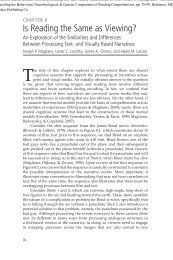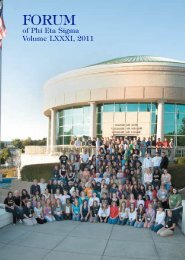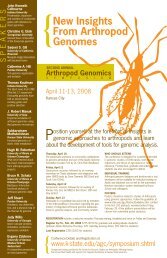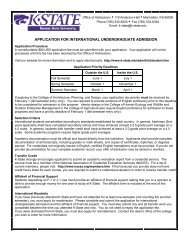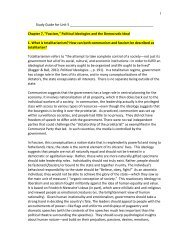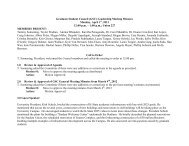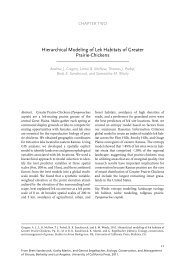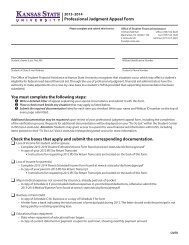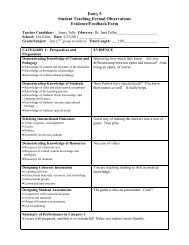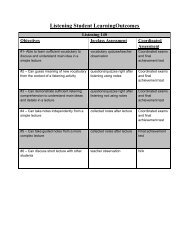Estimation of Demographic Parameters from Live ... - BioOne
Estimation of Demographic Parameters from Live ... - BioOne
Estimation of Demographic Parameters from Live ... - BioOne
You also want an ePaper? Increase the reach of your titles
YUMPU automatically turns print PDFs into web optimized ePapers that Google loves.
temporary emigration (i.e., c ¼ 1 d) as^c t ¼ 1 pˆt/pˆ<br />
t .In<br />
the case <strong>of</strong> nonrandom (or Markovian) temporary emigration,<br />
the probability <strong>of</strong> temporary emigration at time t is<br />
modeled as a function <strong>of</strong> an individual’s status in the<br />
previous occasion (t 1). Thus, robust design models<br />
estimate c separately for individuals that were absent and<br />
remain absent (c9 t<br />
) and individuals that were present but<br />
have temporarily emigrated <strong>from</strong> the sampling area (c 99 t<br />
;<br />
Kendall et al. 1997). The parameter c9 t is sometimes<br />
described as an immigration parameter, but the probability<br />
that an absent individual re-enters the sampling area should<br />
be calculated as the complement: ^d t 9 ¼ 1 ^c t 9. Investigators<br />
also have used robust design models to examine trap<br />
response at time t among individuals that were not trapped<br />
(c t ) or trapped (c t )att 1 (Kendall and Nichols 1995), and<br />
to estimate recruitment <strong>from</strong> in situ reproduction versus<br />
immigration as the number <strong>of</strong> adults in the population at<br />
time t that were young at t 1 (B9 t 1<br />
) or entered the<br />
population as adults between t 1 and t (B 99 t 1<br />
; Nichols and<br />
Pollock 1990).<br />
Robust design models have at least 3 advantages. First, the<br />
closed portion <strong>of</strong> robust design models makes it possible to<br />
obtain robust estimates <strong>of</strong> abundance, which may be <strong>of</strong><br />
interest to wildlife managers. Second, if time-dependence is<br />
present in the demographic parameters, robust design<br />
models may <strong>of</strong>fer parameter estimates for more intervals<br />
than CJS or temporal symmetry models. The closed portion<br />
<strong>of</strong> the model allows estimation <strong>of</strong> c and p* for all occasions;<br />
thus, it is always possible to estimate / for the first and last<br />
intervals <strong>of</strong> a time series. Third, robust design models can<br />
yield estimates <strong>of</strong> / and p with less bias and greater precision<br />
than CJS models. Temporary emigration causes heterogeneity<br />
in encounter rates because individuals with site<br />
propensity have a p* . 0, whereas p* ¼ 0 for emigrants.<br />
Under random temporary emigration, estimates <strong>of</strong> / and p<br />
<strong>from</strong> CJS models are relatively unbiased, but a reduction in<br />
precision occurs (Kendall et al. 1997). Under nonrandom<br />
temporary emigration, estimates <strong>of</strong> / and p <strong>from</strong> standard<br />
CJS models <strong>of</strong>ten are strongly biased, both when c9 t<br />
. ct99<br />
and when c9 t<br />
, ct<br />
99 (Kendall et al. 1997, Fujiwara and<br />
Caswell 2002).<br />
One important application <strong>of</strong> robust design models has<br />
been to investigate temporary emigration in wildlife<br />
populations (Schaub et al. 2004). Temporary emigration is<br />
a poorly understood demographic process that may be a<br />
common feature <strong>of</strong> many wildlife populations. Individuals<br />
marked as young at traditional breeding or wintering<br />
locations may temporarily emigrate <strong>from</strong> such sites and<br />
return to the sampling area after a delay <strong>of</strong> several years<br />
(Fujiwara and Caswell 2002). Similarly, individuals marked<br />
as adults will be temporary emigrants if they skip a breeding<br />
opportunity (Viallefont et al. 1995, Kendall and Bjorkland<br />
2001, Schmidt et al. 2002) or if they temporarily move to a<br />
site where they are not available for capture (Hestbeck et al.<br />
1991, Dinsmore et al. 2003). Marked individuals also can be<br />
temporary emigrants if they remain in the sampling area but<br />
are unavailable for capture. This will be the case whenever<br />
animals are inactive or dormant in belowground refugia<br />
(Schaub and Vaterlaus-Schlegel 2001, Bailey et al. 2004b,<br />
Villella et al. 2004).<br />
Robust design models have provided many <strong>of</strong> the first<br />
empirical estimates <strong>of</strong> temporary emigration. For example,<br />
Bailey et al. (2004b) found that Plethodon salamanders had<br />
high rates <strong>of</strong> temporary emigration (^c ¼ 0.87) because a<br />
substantial proportion <strong>of</strong> the population were belowground<br />
and unavailable for capture. Similarly, male boreal toads<br />
(Bufo boreas) have moderate rates <strong>of</strong> temporary emigration<br />
<strong>from</strong> breeding ponds at high-elevation sites (^c9 ’ ^c99 ¼<br />
0.07–0.55; Muths et al. 2006). Dinsmore et al. (2003)<br />
reported low rates <strong>of</strong> temporary emigration (^c99 ’ 0.23)<br />
among mountain plovers (Charadrius montanus) moving out<br />
<strong>of</strong> their sampling area. Last, Kendall et al. (1997) showed<br />
that the probability <strong>of</strong> temporary emigration in white-footed<br />
mice (Peromyscus leucopus) was highest (grid 1: ^c9 and ^c99 .<br />
0.39, grid 2: ^c . 0.72) during sampling periods when<br />
climatic conditions were cold and mice were inactive in<br />
burrows.<br />
Robust design models also have provided some <strong>of</strong> the first<br />
estimates <strong>of</strong> age-specific variation in breeding propensity.<br />
Breeding propensity is an essential component <strong>of</strong> matrix<br />
models because investigators should calculate fecundity rates<br />
as the product <strong>of</strong> both the probability <strong>of</strong> breeding and the<br />
number <strong>of</strong> <strong>of</strong>fspring produced per breeder. A conventional<br />
assumption in many matrix models is that the probability <strong>of</strong><br />
breeding is 0 among immature or subadult age classes, and it<br />
becomes 1 once an individual attains the age at maturity.<br />
Empirical applications <strong>of</strong> robust design models show that<br />
the probability <strong>of</strong> breeding may increase with age as a step<br />
function in wildlife populations, increasing <strong>from</strong> ^d ¼ 0.67<br />
among 2- to 3-year-olds to ^d ¼ 0.90 among 5 þ -year-old<br />
female black brant (Branta bernicla; Sedinger et al. 2001),<br />
and reaching a maximum at 7 years in grey seals (Halichoerus<br />
grypus; Schwarz and Stobo 1997). Robust design models also<br />
have revealed that the conditional probability <strong>of</strong> breeding<br />
can be ,1 among mature adults: ^d9 ¼ 0.53–0.61 in common<br />
toads (Schmidt et al. 2002), ^d9 ¼ 0.34–0.80 in hawksbill sea<br />
turtles (Eretmochelys imbricata; Kendall and Bjorkland 2001),<br />
and ^d ¼ 0.57 in snow geese (Chen caerulescens; Reed et al.<br />
2004).<br />
A final application <strong>of</strong> robust design models has been to<br />
explore population dynamics by partitioning recruitment<br />
rates into gains <strong>from</strong> local reproduction and immigration by<br />
adults. At least 4 studies have used this approach to estimate<br />
recruitment: a study <strong>of</strong> snow geese (Cooch et al. 2001) and 3<br />
studies <strong>of</strong> small mammals. Population gains <strong>from</strong> local<br />
reproduction were greater than gains <strong>from</strong> immigration<br />
(B9 t 1<br />
. B99 t 1<br />
) in meadow voles (Microtus pennsylvanicus;<br />
Nichols and Pollock 1990) and house mice (Mus musculus;<br />
Pocock et al. 2004), but the opposite was true in red-backed<br />
voles (Clethrionomys rutilus; McDonough and Rexstad<br />
2005).<br />
One hurdle for field applications <strong>of</strong> the robust design<br />
model is that investigators must subdivide sampling effort in<br />
primary periods into shorter secondary periods. Such<br />
1510 The Journal <strong>of</strong> Wildlife Management 70(6)



